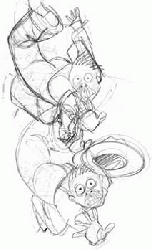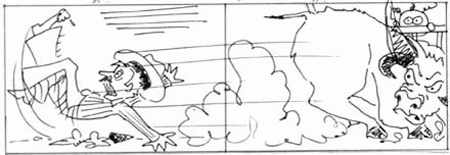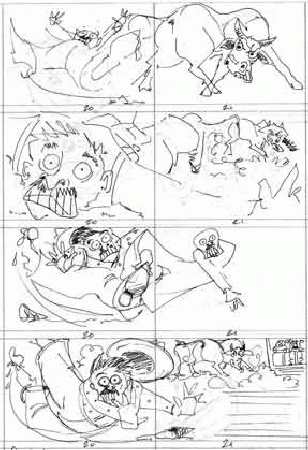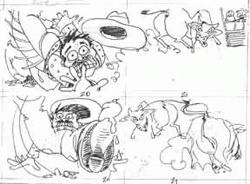Most picture books are 32 pages long. This has to do with the printing process and the way a book like this is bound -- there is less waste and cost associated with multiples of 8 -- but I think, too, it may have something to do with how far into a story a child’s attention span will max out.
When I tell people this bit of trivia, I get mixed responses: “Thirty two pages? How can a writer possibly tell a story in only 32 pages?” or, “You have to illustrate all 32 pages? That’s going to take forever!” or, “Are you sure picture books are 32 pages long, because they just really don’t seem like it.”
If you are going to illustrate 32 pages of a book, whether you think that sounds like a lot or not, you still need a plan, and you need to be able to talk about how you arrived at the end result -- your process -- in case you need to defend your design decisions.
 |
| Lem Falling |
 |
32 pages of illustration is so much more work than the finished product suggests. For the book, Ollie Jolly, Rodeo Clown, I filled entire sketchbooks with cowboys, horses, bulls, ghost towns, and pigs, showed the publisher 96 thumbnails, and sent well over 100 black and white line drawings when the revisions were all tallied. That’s a lot of work for 32 pages.
All artists work differently when approaching a project, but I was taught to work with thumbnails first. Thumbnails are small, rough sketches, which give the artist a feel for the composition of a piece without having to spend hours working through the details at a larger scale. I had an art professor whose favorite line was, “Thirty thumbnails by Wednesday … or don’t bother showing your face in my classroom.” He refused to let us get hung up on deadly, overworked details and he was an advocate of process, process, process. He’d tell us, “If you can get through me, you can get through life. I want to know all the steps you took so I can understand this crap you’re hanging on the wall.” Needless to say, there were a few tears, but we learned how to work as artists.
Publishers, too, want to see what an artist envisions without waiting months for details, and that’s where the thumbnails come in. These quick, small-scale sketches help work out the flow of the book, determine where the reader’s eye moves within each scene, and give the publisher an idea of the direction in which the artist wants to go. In this phase of the project the artist focuses on spatial elements of design, such as composition and audience point of view, without the distraction and clutter of details.
I did three sets of thumbnails for the picture book Ollie Jolly, Rodeo Clown, with revisions based on suggestions from my publisher and editor. In this particular spread, the rodeo clown, Limber Lem, has dashed out to protect Ollie Jolly and his friends from the angry charging bull, Bad Medicine. Unfortunately, he slips on an ice cream cone lying on the ground, and is subsequently knocked out cold. I wanted to explore the image of Lem flying through the air in order to create more suspense in the text while also adding humor to a potentially dangerous situation -- hence the terrified expression on Lem’s face.
 |
| Lem Falls |
 |
The publisher thought this was funny too, but wanted me to play with the point of view a little more. What about seeing Lem straight on with the bull behind? Or from below? Or above?
 |
| Lem Falls 2 |
 |
Could we make this scene even funnier? In order to illustrate the cowboy flying right at the reader, I had to use a technique called “foreshortening.” I spent a lot of time lying on my studio floor in front of a full-length mirror, pretending to fly through the air with my legs sticking straight out. I studied the size relationship between the sole of my foot and my face behind it, while sketching -- all while trying not to fall over.
From the thumbnail stage, an illustrator then works out the whole book in larger, black and white line drawings, called a book “dummy”. These drawings are done to scale, showing character and setting detail, and allow you to flip through the pages as if they were really bound. In this stage, too however, it may become apparent that once the details are added, the illustration still needs more work. One of the problems that I encountered was the fact that I didn’t leave enough room for the author’s text … whoops!
 |
| Lem Falls 3 |
 |
I had to shrink all of my drawings and move them around to make sure that Jo Harper’s hysterical words would fit. I felt like such a novice when I had made this mistake, but my publisher and editor were kind enough to tell me “this was a common mistake that allartists make …” I really wanted to believe them too




